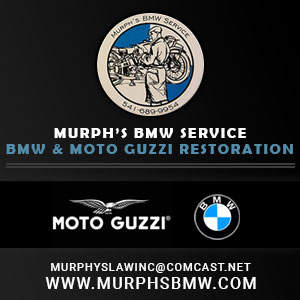Piston Ring End Gap from Snowbum's site
I'm honing cylinders, measuring ring gaps and trying to reach a conclusion as to what to do about rings, bore, pistons, et al.
I was reading Snowbum's site, particularly http://bmwmotorcycletech.info/pistons.htm. He discusses that the shop manual gaps are merely OK at 0.12" - 0.20". He mentions "DO NOT make the mistake of fitting rings with too little end gap!" and explains that his preference is "0.0035" per inch of cylinder bore."
For an R90S standard bore, C size piston at 89.875mm, and a cylinder of 90.02mm (3.544095" *0.0035 (from above) = 0.0124" ring gap which aligns precisely with the BMW shop manual. This is a ring gap at the low end of the spec and is preferred.
I'm confused by the remark "DO NOT make the mistake of fitting rings with too little end gap!" and "Note that BMW rings as supplied may have larger end gaps than the manual states; and are OK. I would NOT be inclined to try to install rings with the minimum the factory specifies ...somewhat more end gap is actually preferable on our Airheads." The specs & personal preference align. I was expecting something different here. - Any thoughts or clarifications, Bob?
As I'm running towards the upper range of the shop manual spec re ring gap, I'm considering an oversize ring.
So if using a 0.5mm oversize ring to better achieve a 'tighter' ring gap, what is the preferred technique to 'grind down rings' to achieve the target gap?
thanks,
bob
As I'm running towards the upper range of the shop manual spec re ring gap, I'm considering an oversize ring.
So if using a 0.5mm oversize ring to better achieve a 'tighter' ring gap, what is the preferred technique to 'grind down rings' to achieve the target gap?
File them a small bit, fit into cylinder, square up with top of piston and measure gap with feeler gauge, repeat until you get it where you want it
Bob -
Good questions and good math.
My only BMW ring job was on my 1979 R100, but have done the same to literally thousands of engines of numerous other European brands of motorcycles. The quoted 0.012" was the number I used on my R100 and is the number I suggest you also aim for. (I should point out that the only engines I work on are air-cooled, 1940 to 1975, and not Harleys.)
• You want the ring end gap set at the minimum becasue the standard iron rings will wear very rapidly during the initial bedding-in period. During that time the gap will widen as material is scuffed off the exterior surface. The minimum gap is the ONLY number I use during new ring installation. I only consult the ring end gap tolerance when re-installing the customer's existing rings.
• The way I learned to adjust ring end gap was to clamp a thin flat file horizontally in a bench vice. Then, holding the ring ends, one in each hand, press the 2 ends against the 2 sides of the file and pull. This has the advantage of keeping the new cut gap parallel.
• Ring end gap is best measured about 1/2 inch down from the top of the bore.... this is a point near the greatest cylinder wear.
• The newest method for top end assembly (and this sounds very counter-intuitive) is to NOT oil the piston rings on assembly. Instead, wipe the bore with a shop rag that had oil on it 2 days ago, so that a thin sheen of oil is present that can only be seen in bright light.
• Honing is best done in a utility sink filled with hot soapy water which helps remove the abrasive. I prefer the ("dingle-berry") bead hones and a cordless drill motor. These will follow every surface fluctuation, which is extremely important when a run-in cylinder is not being bored.
• I crank these engines with clean oil and a box fan supplying cooling air. I run them at constantly varying speeds between 1500 to 3000 RPM for maybe 3-4 minutes. When ever possible, I ride the motorcycle the first 10 miles.
Using multi-piece rings or single-piece oil rings, I have never had an engine fail to perform well.
Hope this helps.
Owning an old Airhead is easy.
Keeping an old Airhead running great is the true test.
understood. I used that technique to determine the ring gap after honing.
The real question is how to keep the 'filed' end perfectly square.
Hi Wobbly,
You got to the crux of my question with your file suggestion as to how to keep the ring ends truly parallel. This is what had been escaping my imagination till now.
Snowbum's remarks about endgap still seem to suggest to me that somehow the BMW min gap should be larger and that is counter-intuitive to me.
I believe from previous re-builds that targeting the min. is the right path based upon initial wear, as you also have concluded.
Thanks for the file suggestion!
bob
Well, BMW does use cast iron rings which will have some initial wear. I'd expect the end gap to grow 0.001 to 0.002" in the first 500 miles, then slow considerably. Especially with today's great oils.
My R100 with 30,000 miles was out to 0.020" gap and running fine. The only reason the top end came off was the classic push rod oil seal leaks.
All the best.
Owning an old Airhead is easy.
Keeping an old Airhead running great is the true test.
Snowbum's remarks about endgap still seem to suggest to me that somehow the BMW min gap should be larger and that is counter-intuitive to me.
I believe from previous re-builds that targeting the min. is the right path based upon initial wear, as you also have concluded.
Doesn't it also depend on piston composition and expansion rate relative to expansion rate of the cylinder in which it is running? Seems like a lot of people get into problems with too little ring gap on old vehicles because they might be used to modern pistons and rings running in aluminum cylinders. That's where snowbum may be coming from. Expansion rate of piston and cylinder in an all-alloy engine are similar and unlike an alloy piston running in an iron cylinder. So BMW gaps are going to be considerably larger than in an all-aluminum engine but perhaps more similar to British bikes for example.
Snowbum's formula works out perfectly for a 650cc Triumph twin which uses a 0.010" ring end gap. And those are solid iron cylinders (with no air passing between) and run much hotter than a BMW.
All cylinders have the piston rings running against iron liners. It's just that some have aluminum fins and cast the heat off faster, thus experiencing less cylinder wear.
There are 2 major gotchas in vintage/classic engine building.... First, and this is the one that probably gets novice engine restorers... older, slower rev-ing, long-stroke engines use only cast iron rings. But the most common rings these days are chrome, which are great in high rev-ing, short-stroke, overhead cam auto and motorcycles, but terrible in tractors. Another contributing factor would probably be air-cooled versus water-cooled. Because the water causes the iron liner to reach temperature much more slowly.
Owning an old Airhead is easy.
Keeping an old Airhead running great is the true test.
sure, makes sense. I get not going under the BMW min spec, it was the part of the remark that suggested even the min spec was too tight although the calculation method produced exactly the same as the min spec that left me a bit bewildered.
Actually his formula almost exactly duplicated the BMW spec 0.012" vs 0.0124".
the added remark that the BMW min spec should be avoided is what threw me.
But thanks to your file suggestion, I have a repeatable method to modify the end gap while maintaining the square ends (or nearly so).
Now the challenge is to find a file coarser than a points file and smoother than rasp 🙂 piece o' cake.
thanks
bob
Sure, understood.
I like reading Snowbum's accounts, there is definitely a treasure trove of Airhead information there. However he seems to practice a very localized editing technique, which when you or I read the entire piece leaves the total presentation somewhat disjointed and sometimes conflicting. Frankly, some of his pages leave me screaming after 10 minutes ! I have to take Snowbum in very small doses. LOL I'm also very sure that in some corner of the motorcycle universe, my own writing has reduced one or two ardent motorcyclists to alcoholics. The internet simply has a way of throwing the technically needy into the lion's den of poorly executed explanation.
And that's the common issue for all technical content columns.... You're either a mechanic with a head full of very desirable information, but no real writing skills, OR your a very competent technical writer who can clearly explain technical details with no real mechanical understanding. The internet is full of laughable examples... The short, gruff, response is probably a guy that knows his stuff, but can't get it out. On the other hand, the eloquent and well presented explanation is probably a bunch of BS ! Oak was a rare exception to this observation. There are certainly others.
So, read Snowbum knowing he's full of good intentions, but keep the "grain of salt" ready.
Owning an old Airhead is easy.
Keeping an old Airhead running great is the true test.
yep, like all 'tech' experts, a grain (or shaker) of salt is req'd.
i find that reading as many different takes on the same topic when combined with some common sense enables me to find my own path forward using the 'good' bits & pieces. thanks 🙂
- 27 Forums
- 1,812 Topics
- 10.3 K Posts
- 0 Online
- 5,564 Members





